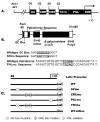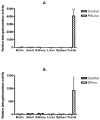Regulation of murine lactate dehydrogenase C (Ldhc) gene expression
- PMID: 18057313
- PMCID: PMC2311504
- DOI: 10.1095/biolreprod.107.064964
Regulation of murine lactate dehydrogenase C (Ldhc) gene expression
Abstract
Expression of Ldhc begins with the onset of meiosis in male germ cells and continues throughout spermatogenesis. Transcriptional regulatory mechanisms, especially in primary spermatocytes, are poorly described because of the lack of a reliable cell culture system. We constructed mouse transgenics and transfected germ cells in situ to study expression of the testis-specific isozyme of lactate dehydrogenase (LDH). From previous work, we determined that a 100-bp Ldhc core promoter contained potential cis regulatory elements, including a palindrome (-21 to +10), GC box (-70 to -65), and cAMP-responsive element (CRE) sites (-53 to -49, -39 to -35). We provide here the demonstration of a functional role for these sequences by expression of mutated transgenes in vivo. Our results reveal for the first time that mutation of the GC box does not abolish promoter activity, which remains testis-specific. Mutation of GC box or CRE sites resulted in a 73% and 74% reduction in promoter activity, respectively, in a transient transfection of germ cells in vivo by electroporation; the combination of GC box and CRE site mutations eliminates promoter activity. Therefore, we conclude that simultaneous occupancy of the GC box and CRE sites in the core promoter is necessary for full expression of Ldhc in the testis.
Figures







Similar articles
-
A-MYB (MYBL1) stimulates murine testis-specific Ldhc expression via the cAMP-responsive element (CRE) site.Biol Reprod. 2012 Feb 9;86(2):30. doi: 10.1095/biolreprod.111.095661. Print 2012 Feb. Biol Reprod. 2012. PMID: 21998171 Free PMC article.
-
ldhc expression in non-germ cell nuclei is repressed by NF-I binding.J Biol Chem. 2001 Sep 21;276(38):35414-21. doi: 10.1074/jbc.M101269200. Epub 2001 Jul 10. J Biol Chem. 2001. PMID: 11447215
-
Molecular and functional characterization of the murine ldh2 promoter region: Sp-binding GC-box domains are the key cis-elements regulating ldh2 gene expression during spermatogenesis.Mol Cell Endocrinol. 2008 Nov 25;295(1-2):10-7. doi: 10.1016/j.mce.2008.08.016. Epub 2008 Aug 23. Mol Cell Endocrinol. 2008. PMID: 18790003
-
A 60-bp core promoter sequence of murine lactate dehydrogenase C is sufficient to direct testis-specific transcription in vitro.Biol Reprod. 1994 Sep;51(3):425-32. doi: 10.1095/biolreprod51.3.425. Biol Reprod. 1994. PMID: 7803614
-
LDHC: the ultimate testis-specific gene.J Androl. 2010 Jan-Feb;31(1):86-94. doi: 10.2164/jandrol.109.008367. Epub 2009 Oct 29. J Androl. 2010. PMID: 19875487 Free PMC article. Review.
Cited by
-
Functional cooperation between CREM and GCNF directs gene expression in haploid male germ cells.Nucleic Acids Res. 2010 Apr;38(7):2268-78. doi: 10.1093/nar/gkp1220. Epub 2010 Jan 13. Nucleic Acids Res. 2010. PMID: 20071744 Free PMC article.
-
Correlation between promoter methylation of the LDH-C4 gene and DNMT expression in breast cancer and their prognostic significance.Oncol Lett. 2022 Jan;23(1):35. doi: 10.3892/ol.2021.13153. Epub 2021 Dec 1. Oncol Lett. 2022. PMID: 34966451 Free PMC article.
-
A-MYB (MYBL1) stimulates murine testis-specific Ldhc expression via the cAMP-responsive element (CRE) site.Biol Reprod. 2012 Feb 9;86(2):30. doi: 10.1095/biolreprod.111.095661. Print 2012 Feb. Biol Reprod. 2012. PMID: 21998171 Free PMC article.
-
Comparative expression profiling of testis-enriched genes regulated during the development of spermatogonial cells.PLoS One. 2017 Apr 17;12(4):e0175787. doi: 10.1371/journal.pone.0175787. eCollection 2017. PLoS One. 2017. PMID: 28414809 Free PMC article.
-
Testis-specific lactate dehydrogenase is expressed in somatic tissues of plateau pikas.FEBS Open Bio. 2013 Feb 4;3:118-23. doi: 10.1016/j.fob.2013.01.011. Print 2013. FEBS Open Bio. 2013. PMID: 23772382 Free PMC article.
References
-
- Hintz M, Goldberg E. Immunohistochemical location of LDH-X during spermatogenesis in mouse testes. Dev Biol. 1977;57:375–384. - PubMed
-
- Li S, Zhou W, Doglio L, Goldberg E. Transgenic mice demonstrate a testis-specific promoter for lactate dehydrogenase, Ldhc. J Biol Chem. 1998;273:31191–31194. - PubMed
-
- Zhou W, Goldberg E. A dual-function palindromic sequence regulates testis-specific transcription of the mouse lactate dehydrogenase c gene in vitro. Biol Reprod. 1996;54:84–90. - PubMed
-
- Thomas K, Sung DY, Yang J, Johnson K, Thomas W, Millette C, McCarrey J, Breitberg A, Gibbs R, Walker W. Identification, characterization, and functional analysis of SP1 transcript variants expressed in germ cells during mouse spermatogenesis. Biol Reprod. 2005;72:898–907. - PubMed
Publication types
MeSH terms
Substances
Grants and funding
LinkOut - more resources
Full Text Sources
Molecular Biology Databases
Miscellaneous

